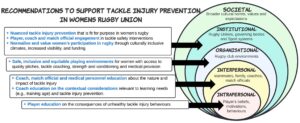In this blog we will explain the results of our recent study published in BJSM. We conducted a qualitative study using a grounded theory approach to capture the tackle injury experiences and behaviours in women’s rugby union.
Why is this study important?
Women’s Rugby is one of the fastest growing sports worldwide (1). Tackle-related injuries remain a problem in the women’s game, accounting for up to 67% of all match injuries (2). It is important to understand tackle injuries to prevent potential negative consequences such as disruption to sport participation, reduced physical activity and potential long-lasting impact.
The sport’s governing body, World Rugby, has committed to funding evidence-informed injury prevention programmes, but research in women’s rugby is still playing catch-up. We can only assume that tackle coaching frameworks and injury prevention strategies are likely informed by research in men’s rugby (3). Understanding of the performance context is essential for the success of injury prevention strategies (4). This study is important since it is the first to explore tackle injury experiences in women’s rugby players from Europe, North America and Africa.
How did the study go about this?
We interviewed 21 senior women’s rugby players using qualitative grounded theory methods. We asked players about their experiences of tackle injuries and tackle skill learning. Players were aged between 20-48 years and came from diverse backgrounds and sporting systems in the UK, Ireland, France, Canada and South Africa. The playing experiences of participants ranged from 12 months to 20 years from club to elite international level.
What did the study find?
We found that player’s considered tackling a highly complex skill that requires technical, tactical, physical and psychological proficiency to execute safely and effectively. The majority of participants’ first introduction to rugby was in adulthood through university or clubs and in some cases participants were ‘fast tracked’ (less than 1 year participation) to compete internationally.
We found that tackle injuries were common in women’s rugby. Players reported a sense of fear and lack of confidence in their experience of tackling but felt that tackle injuries were an inevitable part of the game. Players described ‘playing catch-up’ in terms of tackle preparedness, noting how their status as women and late starters in rugby increased their risk of injury. Interactions with teammates, coaches and the rugby culture that normalised injury and rewarded ‘putting your body on the line’ shaped player’s tackle injury beliefs and behaviours. For example, players commonly played through pain and injuries and were only taken seriously when they impeded a player’s ability to perform.
“I broke my finger in the warm-up before an international game and one of the girls turned
and said to me that ‘it’s just a mindset’, and it was. You just play the game, strap it up, get a
load of pain killers into you and just play the game.” (participant quote)
Women’s tackle injury experiences were often intertwined with day-to-day realities of marginalisation (e.g., gender stereotypes, homophobia and stigma) and underpreparedness. These experiences were often situated alongside tackle coaching that paid little attention to player wellbeing or the training age and learning needs of their players. On account of inequalities in club structures, women’s rugby teams counted themselves lucky to have access to the gym, pitches and pitch-side medical support.
What are the key take-home points?
Tackle injuries are common and carry considerable physical and emotional burden in women’s rugby. Beyond the stakeholders directly related to the players (e.g., teammates, coaches, match officials), there are other dimensions (e.g., club environments, rugby culture and wider society) that affect tackle injury experiences in women’s rugby. By adopting a nuanced, collective approach (4) that reflects the complexity of the skill of tackling and accounts for the performance context and preferences of women’s rugby players we will be better placed to protect player health in rugby. The figure below shows some practical recommendations that can be used in designing effective tackle frameworks for women’s rugby.
Figure 1: Practical Recommendations to Support Tackle Injury Prevention in Women’s Rugby Union (Adapted from Bronfenbrenner 1979 ecological systems model (5)).

References
1) World Rugby. New report highlights global rise in rugby interest in 2019 (2020); 2020. Available: https://www.world.rugby/news/600417/new-report-highlights-global-rise-in-rugby-interest-in-2019 [Accessed 03 Aug 2022].
2) West S, Shill I, Patricios J, et al. 461 narrowing the gender gap in rugby injury epidemiology: a novel video-analysis study in the women’s game. Br J Sports Med 2021;55:A176. doi:10.1136/bjsports-2021-IOC.422
3) Dane K, Simms C, Hendricks S, et al. Physical and technical demands and preparatory strategies in female field collision sports: a scoping review. Int J Sports Med 2022;43:1173–82. doi:10.1055/a-1839-6040
4) Hendricks S, Emery C, Jones B, et al ‘Tackling’ rugby safety through a collective approach British Journal of Sports Medicine 2023;57:562-563. doi:10.1136/bjsports-2023-107020
5) Bronfenbrenner U. The ecology of human development: experiments by nature and by design. Harvard: Harvard University Press, 1979.
Authors
Kathryn Dane 1, Geraldine Foley 2 , Fiona Wilson 1
- Discipline of Physiotherapy, Trinity College Dublin School of Medicine, Dublin, Ireland
- Discipline of Occupational Therapy, Trinity College Dublin School of Medicine, Dublin, Ireland
Conflict of interest: FW is an Deputy Editor for the British Journal of Sports Medicine